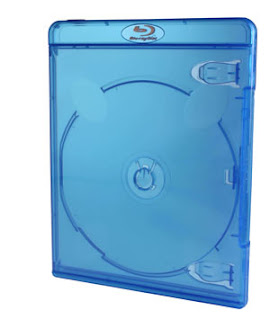 |
| Blu-ray cases are characterized by their electric-blue, semi-transparent color and unique size. |
What's interesting about Blu-ray packaging is the different approach that Blu-ray manufacturers took as opposed to when DVD packaging was established. When DVDs first entered the market, manufacturers worked closely with VHS rental stores and resellers to create a case that worked with their existing point of sale displaces. As a result, DVD cases have the same height and width (as in depth, not thickness) as VHS packaging. This ensured that resellers and rental stores were able to immediately offer DVDs without purchasing new shelves and display units.
Blu-ray, however, they set out to differentiate itself from DVDs, while establishing itself as a direct competitor to HD DVD, which had a head start in the hi-def market. As a result, the new case had the same dimensions as the HD DVD case, but was electric blue, instead of the red color HD DVDs used. The new case size and electric-blue color ensured that consumers knew they were purchasing a Blu-ray disc, with all the benefits this format had to offer.
From the perspective of protecting your disc, probably any disc package would work for Blu-ray discs. Blu-rays – thanks to their super-tough, scratch resistant coating – are actually more resilient than DVDs or CDs. However, from a marketing perspective, the Blu-ray cases are better because they help with the "perceived value" of your Blu-ray product. When your customer makes a purchase and receives your disc in an authentic Blu-ray case it reinforces the idea that they are getting a Blu-ray product. So, if you want to remind your customer that they are getting the newest, highest-quality, hi-def product, stick with authentic Blu-ray cases.

No comments:
Post a Comment